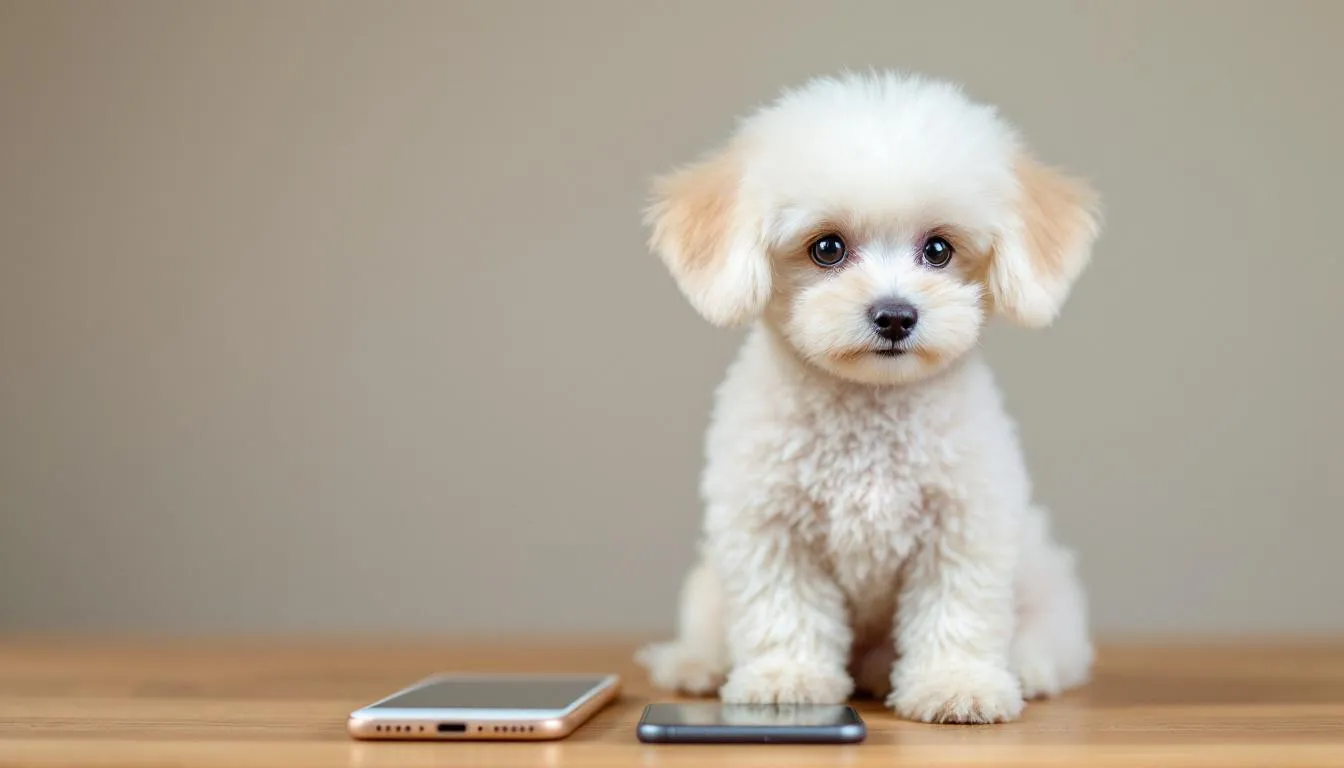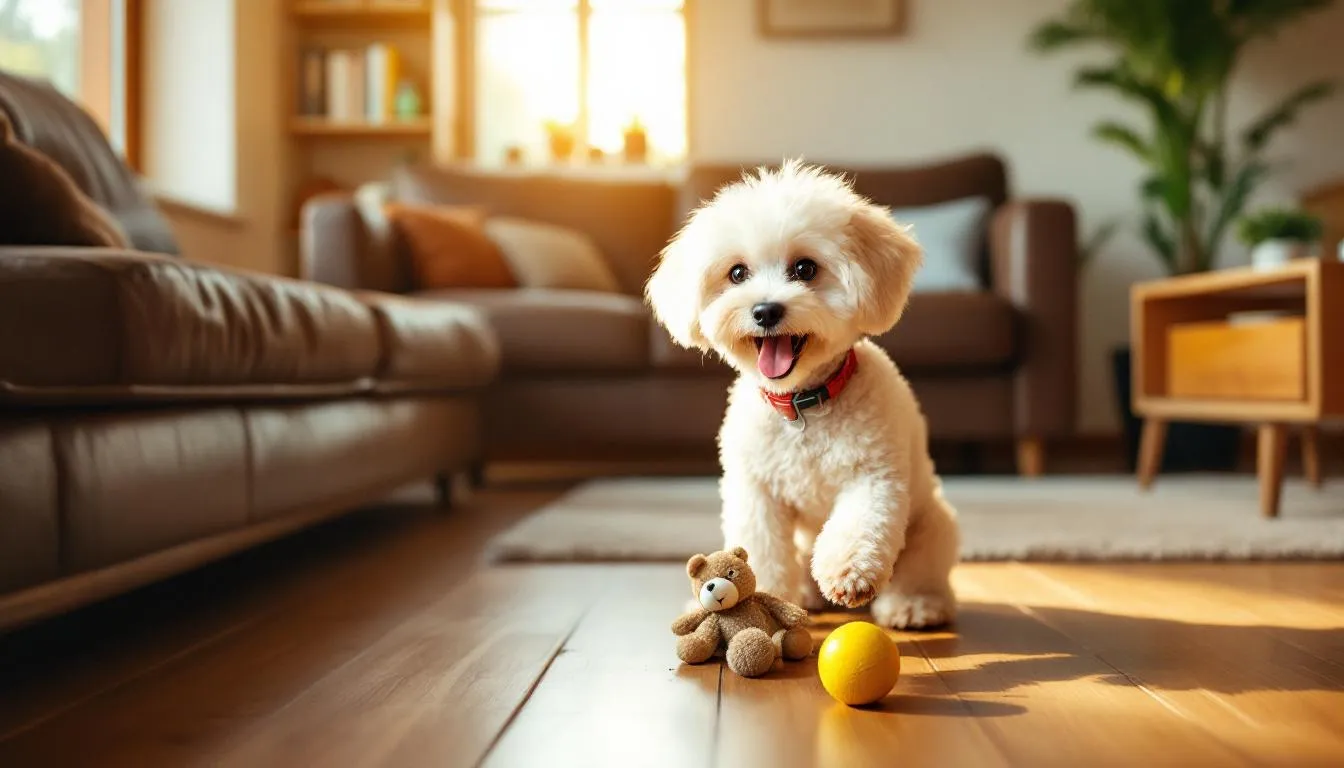Key Takeaways
- Teacup poodles are not an official breed but selectively bred toy poodles weighing under 6 pounds and standing less than 9 inches tall
- These tiny dogs are highly intelligent, affectionate, and make excellent apartment pets but require careful handling due to their fragile size
- Health concerns are common in teacup poodles due to their extremely small size, including hypoglycemia, heart defects, and respiratory issues
- Prices typically range from $1,500 to $3,500 from reputable breeders, with proper grooming and care being essential for their wellbeing
- They have a lifespan of 12-15 years and are considered hypoallergenic with minimal shedding, making them suitable for allergy sufferers
Teacup poodles are not an official breed but selectively bred toy poodles weighing under 6 pounds and standing less than 9 inches tall
These tiny dogs are highly intelligent, affectionate, and make excellent apartment pets but require careful handling due to their fragile size
Health concerns are common in teacup poodles due to their extremely small size, including hypoglycemia, heart defects, and respiratory issues
Prices typically range from $1,500 to $3,500 from reputable breeders, with proper grooming and care being essential for their wellbeing
They have a lifespan of 12-15 years and are considered hypoallergenic with minimal shedding, making them suitable for allergy sufferers
Weighing less than a small bag of flour and standing shorter than a laptop, teacup poodles capture hearts with their impossibly tiny size and adorable looks. These miniature companions pack enormous personality into their small stature, making them increasingly popular among urban dwellers and families seeking a portable, intelligent pet.
However, their cute appearance comes with significant responsibilities. Understanding what makes these dogs special—and the challenges they face—helps determine if a teacup poodle is the right dog for your lifestyle and family.
Introduction to Teacup Poodles Easy to Love
Teacup Poodles are a captivating variation of the beloved Toy Poodle breed, celebrated for their adorable looks, small stature, and affectionate personalities. These tiny dogs are selectively bred to be even smaller than the standard Toy Poodle, making them a favorite among those seeking a compact, loving companion. Despite their petite size, teacup poodles are remarkably intelligent and energetic, thriving on regular mental stimulation and interactive play. Their low shedding coat makes them one of the best choices for people with allergies, but it’s important to note that their beautiful curls require regular brushing to prevent matting and keep them looking their best. While their size adds to their charm, it also means they can be prone to certain health issues, such as luxating patellas, so attentive care is essential. If you’re searching for a breed that combines adorable, tiny features with a lively, affectionate spirit, the teacup poodle may be the perfect fit for your home.
History, Origin, and the Teacup Poodle Breeder
The story of the teacup poodle begins with the rich history of the poodle breed itself. Originally developed in Germany during the 15th century, poodles were prized as waterfowl hunting dogs, known for their intelligence and versatility. Over time, breeders began to create smaller versions of the poodle, leading to the development of the Miniature and Toy Poodle varieties. The term “teacup” emerged to describe the smallest of these toy poodles—dogs that weigh less than 6 pounds and stand under 9 inches tall. While teacup poodles are not officially recognized as a separate size by major kennel clubs, their adorable, affectionate nature and tiny size have made them increasingly popular as companion dogs. Today, teacup poodles are cherished for their ability to bring big personality and love into even the smallest of living spaces.


What is a Teacup Poodle?
A teacup poodle represents the smallest possible version of the beloved poodle breed, standing under 9 inches tall and weighing less than 6 pounds when fully grown. Despite their popularity, teacup poodles aren’t recognized as an official breed by major kennel clubs like the American Kennel Club (AKC). Instead, they’re selectively bred toy poodles that fall below the standard toy poodle size requirements.
The breeding of these exceptionally small dogs began gaining momentum over the past 20 years as demand for smaller dogs increased, particularly in urban environments where space is limited. Teacup poodle breeders achieve these tiny sizes by consistently selecting the smallest toy poodles for breeding, often choosing runts or naturally smaller individuals from litters. Some dogs are affected by health issues as a result of being bred to be unusually small. While very small poodles can happen naturally, deliberate breeding for tiny size increases the risk of health problems in affected dogs.
To understand where teacup poodles fit, it helps to know the official sizes recognized for poodles:
- Standard Poodle : 22-27 inches tall, 45-70 pounds
- Miniature Poodle : 13-15 inches tall, 26-31 pounds
- Toy Poodle : 10 inches and under, 14-17 pounds
- Teacup Poodle : Under 9 inches, 2.5-6 pounds (unofficial)
Standard Poodle : 22-27 inches tall, 45-70 pounds
Miniature Poodle : 13-15 inches tall, 26-31 pounds
Toy Poodle : 10 inches and under, 14-17 pounds
Teacup Poodle : Under 9 inches, 2.5-6 pounds (unofficial)
In Europe, the moyen/Klein size is recognized, and the term 'teacup' is less standardized outside of Europe.
All teacup poodles are technically toy poodles, but not all toy poodles qualify as teacups. This distinction matters when researching breeders and understanding what you’re getting.


Physical Characteristics and Appearance Including Do Teacup Poodles Shed
Teacup poodles maintain all the classic poodle features in an incredibly compact package. Their round heads feature floppy ears that hang close to the head, alert dark eyes that convey intelligence, and longer muzzles proportional to their skull size. Despite their tiny dimensions, they maintain the square body structure characteristic of all poodles, with legs that appear long relative to their overall size.
The breed’s signature feature remains their thick, curly coat that requires regular brushing to maintain its soft texture and prevent matting. This coat comes in numerous colors including blue, black, brown, gray, silver, red, beige, white, café, and apricot. Some teacup poodles display solid colors while others may show subtle variations. In some cases, teacup poodles may exhibit point coloration, where the face, ears, paws, and tail are darker than the rest of the body, adding to their distinctive appearance.
Coat Type and Grooming Needs
One major advantage of teacup poodles is their hypoallergenic qualities. Teacup poodles shed very little, making them a popular choice for people seeking low-shedding or hypoallergenic dogs. These low shedding dogs produce minimal dander, making them suitable for people with allergies. However, their beautiful coat demands consistent maintenance.
Daily brushing prevents the formation of mats and tangles that can become painful if left unaddressed. Professional grooming every 6-8 weeks keeps their coat healthy and manageable. Many owners also trim hair around the eyes regularly to ensure clear vision and maintain hygiene.
Temperament and Personality
Despite their small size, teacup poodles possess big personalities. These intelligent, loyal, and affectionate dogs form strong bonds with their families and often prefer constant companionship. Their alert nature makes them excellent watchdogs despite their tiny stature—they’re quite vocal when strangers approach or unfamiliar sounds occur.
Teacup poodles are eager to please, which, combined with their quick learning ability, makes them easy to train when approached with patience and positive reinforcement. They’re naturally energetic and playful, enjoying games and mental stimulation to keep their active minds engaged.
However, their strong attachment can lead to separation anxiety if left alone for extended periods. These dogs thrive in households where someone is frequently home or where they can accompany their humans throughout the day.
Compatibility with Families and Children
Teacup poodles can integrate well into families, but their fragile size requires careful consideration when children are involved. They’re best suited for families with older, calmer children who understand the importance of gentle handling. Very young children may inadvertently injure these delicate dogs during play.
Supervision is essential during any interaction between teacup poodles and kids. Their tiny bones can break easily, and their small size makes them vulnerable to accidental harm. Loud noises or chaotic environments can easily scare teacup poodles, leading to anxiety or behavioral issues. However, when properly introduced and monitored, these dogs often become devoted family companions.
Socialization with Other Pets
Generally friendly and social by nature, teacup poodles typically get along well with other animals when properly socialized. However, their small size creates safety concerns when interacting with larger dogs who might play too roughly without realizing their strength advantage.
Careful introduction techniques and ongoing supervision help ensure positive relationships with other pets. Many teacup poodles adapt well to multi-pet households, particularly when raised alongside other animals from a young age.
Training and Intelligence
Poodles consistently rank among the most intelligent dog breeds, and teacup poodles inherit this cognitive ability despite their size. Their combination of intelligence and eagerness to please makes them highly trainable companions who can learn complex tricks and commands with consistent practice.
Mental stimulation becomes crucial for these bright dogs. Puzzle toys, training sessions, and interactive games prevent boredom and destructive behaviors. Their quick learning ability means they respond well to positive reinforcement techniques, though their sensitive nature requires gentle, patient training approaches.
The best way to train teacup poodles involves short, frequent sessions that maintain their attention while building skills gradually. Owners should spend quality time engaging their teacup poodles in training and interactive activities to keep them mentally stimulated. Their intelligence allows them to excel at various activities, from basic obedience to more advanced tricks that showcase their capabilities.


Exercise and Energy Requirements
While teacup poodles are energetic and playful, their exercise needs remain moderate due to their size. Two 15-minute walks daily typically provide adequate physical exercise, supplemented by indoor play sessions that allow them to expend energy safely.
Their small legs cover less ground than larger breeds, making apartment living ideal for meeting their exercise requirements. Indoor games, toy interactions, and short training sessions can easily fulfill their daily activity needs when outdoor exercise isn’t possible.
Mental stimulation often proves more important than intense physical exercise for these intelligent dogs. Puzzle feeders, training sessions, and interactive toys help tire their minds while providing necessary enrichment.
Health Concerns and Common Issues
The extreme miniaturization required to create teacup poodles unfortunately increases their risk of various health problems compared to larger poodle varieties. Responsible ownership requires understanding these potential issues and working with veterinarians experienced in treating tiny breeds.
Common health concerns in teacup poodles include:
- Hypoglycemia : Dangerously low blood sugar, particularly in puppies, due to their fast metabolism and tiny size
- Luxating patellas : Kneecap dislocation common in small breeds
- Heart defects : Including patent ductus arteriosus and other congenital conditions
- Respiratory issues : Collapsing trachea and breathing difficulties
- Dental disease : Overcrowding and early tooth loss due to small jaw size
- Seizure disorders : Neurological issues that may be inherited
- Legg-Calve-Perthes disease : Hip joint deterioration affecting mobility
Hypoglycemia : Dangerously low blood sugar, particularly in puppies, due to their fast metabolism and tiny size
Luxating patellas : Kneecap dislocation common in small breeds
Heart defects : Including patent ductus arteriosus and other congenital conditions
Respiratory issues : Collapsing trachea and breathing difficulties
Dental disease : Overcrowding and early tooth loss due to small jaw size
Seizure disorders : Neurological issues that may be inherited
Legg-Calve-Perthes disease : Hip joint deterioration affecting mobility
Their fragile bone structure also increases injury risk from falls, rough play, or accidental impacts. Many owners invest in pet stairs to prevent jumping injuries and maintain careful supervision during activities.
Lifespan and Longevity
Despite health challenges, well-cared-for teacup poodles typically live 12-15 years, similar to other small dog breeds. Factors affecting longevity include genetics, quality of breeding, veterinary care, nutrition, and overall lifestyle management.
Regular veterinary checkups become especially important for monitoring health issues common in tiny breeds. Early detection and treatment of problems can significantly impact quality of life and lifespan.
Care and Maintenance
Teacup poodles require dedicated daily care due to their size and specific needs. These dogs need frequent interaction to prevent anxiety and behavioral issues. Their small bladders mean more frequent potty breaks, and their tiny stomachs require multiple small meals throughout the day rather than one or two large portions.
Temperature sensitivity affects these dogs more than larger breeds. They often need sweaters in cold weather and protection from overheating in summer. Many owners find that indoor living provides the most controlled environment for their delicate pets.
Safety measures become essential in households with teacup poodles. Doggy stairs prevent injuries from jumping off furniture, and careful attention to their location prevents accidental stepping or sitting incidents.
Nutrition and Feeding Guidelines
High-quality nutrition supports the health of these tiny dogs, with daily caloric needs around 250 calories split into multiple small meals. A half to one cup of high-quality dry or wet food daily typically meets their nutritional requirements, though individual needs vary based on age, activity level, and health status.
Portion control becomes critical since excess weight strains their delicate frame and can exacerbate health problems. Regular veterinary guidance helps adjust feeding amounts as dogs age and their metabolism changes.


Living Situations and Suitability
Teacup poodles excel as apartment dogs due to their small size and moderate exercise needs. Their indoor lifestyle preferences align perfectly with urban living, where space constraints make larger breeds impractical. Teacup poodles are recognized around the world as one of the lowest-shedding dog breeds.
Despite their size, these dogs retain watchdog instincts and will alert owners to visitors or unusual sounds. Their portable nature makes them excellent travel companions for owners who want to bring pets along on trips.
Some teacup poodles work as therapy or emotional support animals due to their affectionate nature and small size that allows easy transport to various locations. However, their fragility limits their suitability for more demanding service work.
Lifestyle Considerations
Welcoming a teacup poodle into your family is a rewarding experience, but it comes with unique lifestyle considerations. As a small dog, the teacup poodle thrives in environments where gentle handling and attentive care are the norm. They require regular exercise, consistent training, and plenty of mental stimulation to stay happy and healthy. Because of their delicate build, they are best suited for families with older children who understand how to interact safely with smaller dogs. Additionally, teacup poodles can be prone to health issues, making it crucial to work with a reputable breeder who prioritizes health testing and responsible breeding practices. If you’re considering adding a teacup poodle to your home, take the time to research reputable breeders, and don’t overlook the possibility of adoption through rescues or dedicated websites. With the right commitment to training, health, and love, teacup poodles can become cherished, healthy members of your family for years to come.
Cost and Purchasing Considerations
Teacup poodle prices typically range from $1,500 to $3,500 from reputable breeders, with some exceptional bloodlines commanding higher prices. Finding a reputable teacup poodle breeder is crucial to ensure ethical breeding practices. Several factors influence cost, including the breeding difficulty associated with producing healthy tiny puppies and the small litter sizes that typically yield only 1-2 puppies per breeding.
Additionally, owners should expect ongoing costs for specialized care, frequent grooming, potential health issues, and equipment designed for tiny dogs. These expenses can add up significantly over the dog’s lifetime.
Prospective owners may need to wait on a teacup poodle breeder's waitlist due to limited availability and high demand. Quality breeders often maintain waiting lists due to limited availability and high demand. Be wary of breeders offering immediate availability at unusually low prices, as this often indicates puppy mill operations or irresponsible breeding practices. Responsible breeders provide transparent information about their breeding practices and available puppies on their sites.
Finding Reputable Breeders
Research becomes crucial when seeking a healthy teacup poodle. Reputable breeders provide health testing results for parent dogs, allow visits to meet the parents, and offer ongoing support throughout the dog’s life. They’ll ask questions about your lifestyle and experience to ensure good matches.
Many reputable breeders and owners use Instagram to share photos, updates, and connect with potential buyers, making it a useful platform for verifying breeder credibility.
Red flags include breeders who won’t allow facility visits, lack health records, offer multiple breeds, or seem more interested in quick sales than puppy welfare. Take time to research and visit potential breeders before making decisions.
Adoption Options
While rare, teacup poodles occasionally appear in rescue organizations and shelters. Poodle-specific rescues sometimes have smaller dogs available for adoption. Monitor rescue websites and submit applications early, as these dogs typically have multiple interested families.
Adoption offers the benefit of potentially saving a dog in need while often providing a lower-cost option compared to purchasing from breeders. However, rescued dogs may come with unknown health histories or behavioral challenges requiring patience and dedication.


Is a Teacup Poodle Right for You?
Determining if a teacup poodle fits your lifestyle requires honest self-assessment. Factors such as health, size, and temperament matter greatly when deciding if a teacup poodle is the right fit for you. Ideal owners are dedicated, patient, and gentle individuals who can provide consistent care and attention. These dogs need owners willing to invest time in grooming, training, and companionship.
The financial commitment extends beyond purchase price to include regular veterinary care, professional grooming, high-quality nutrition, and potential health-related expenses. Families wanting low-maintenance or highly durable dogs should consider other breeds better suited to active lifestyles.
Consider these questions when deciding:
- Can you provide gentle, consistent care daily?
- Are you prepared for potential health issues and veterinary costs?
- Do you have time for regular grooming and training?
- Will someone be home frequently to prevent separation anxiety?
- Are household members aware of handling requirements?
Can you provide gentle, consistent care daily?
Are you prepared for potential health issues and veterinary costs?
Do you have time for regular grooming and training?
Will someone be home frequently to prevent separation anxiety?
Are household members aware of handling requirements?
FAQ
Can teacup poodles be shown in dog shows?
No, teacup poodles cannot compete in AKC conformation shows since they don’t meet the breed standards for toy poodles. However, some specialty shows and competitions specifically for teacup breeds do exist, and they can participate in other AKC events like agility or obedience if registered as toy poodles.
Are teacup poodles good for first-time dog owners?
Teacup poodles can work for dedicated first-time owners willing to learn their specific care requirements, but they’re not the easiest starter breed. Their fragility, potential health issues, and need for consistent training require committed owners. Research and preparation are essential for success.
How do I prevent my teacup poodle from getting injured?
Use doggy stairs for furniture access, supervise interactions with larger pets and children, avoid high surfaces, and handle them gently during play. Create a safe environment by removing hazards at their eye level and being constantly aware of their location to prevent accidental injuries.
What’s the difference between a teacup poodle and a toy poodle?
Teacup poodles are simply extra-small toy poodles that weigh under 6 pounds and stand less than 9 inches tall, while standard toy poodles can weigh up to 17 pounds and stand up to 10 inches. Both are technically the same breed, with teacups representing the smallest end of the toy poodle size spectrum.
Do teacup poodles need special veterinary care?
Yes, they require veterinarians experienced with tiny breeds due to their increased risk of hypoglycemia, dental issues, and size-related health problems. Their small size makes routine procedures like anesthesia more challenging, and they need careful monitoring during any medical treatments or surgeries.
FAQ
Can teacup poodles be shown in dog shows?
No, teacup poodles cannot compete in AKC conformation shows since they don’t meet the breed standards for toy poodles. However, some specialty shows and competitions specifically for teacup breeds do exist, and they can participate in other AKC events like agility or obedience if registered as toy poodles.
Are teacup poodles good for first-time dog owners?
Teacup poodles can work for dedicated first-time owners willing to learn their specific care requirements, but they’re not the easiest starter breed. Their fragility, potential health issues, and need for consistent training require committed owners. Research and preparation are essential for success.
How do I prevent my teacup poodle from getting injured?
Use doggy stairs for furniture access, supervise interactions with larger pets and children, avoid high surfaces, and handle them gently during play. Create a safe environment by removing hazards at their eye level and being constantly aware of their location to prevent accidental injuries.
What’s the difference between a teacup poodle and a toy poodle?
Teacup poodles are simply extra-small toy poodles that weigh under 6 pounds and stand less than 9 inches tall, while standard toy poodles can weigh up to 17 pounds and stand up to 10 inches. Both are technically the same breed, with teacups representing the smallest end of the toy poodle size spectrum.
Do teacup poodles need special veterinary care?
Yes, they require veterinarians experienced with tiny breeds due to their increased risk of hypoglycemia, dental issues, and size-related health problems. Their small size makes routine procedures like anesthesia more challenging, and they need careful monitoring during any medical treatments or surgeries.






